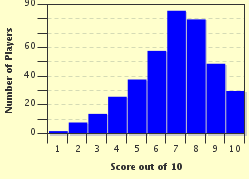Quiz Answer Key and Fun Facts
1. In which of these genres of literature are you LEAST likely to find a dungeon?
2. The Tower of London is not an underground dungeon, but it is a famous prison. In which Shakespearean play do we see a king arranging the deaths of some young relatives imprisoned in the Tower of London?
3. This lighthearted picture shows someone investigating a Portuguese pit dungeon that was built in 1507. Who wrote "The Pit and the Pendulum", a story about being tortured by the Spanish Inquisition?
4. Alexandre Dumas (pere) wrote a tale of Edmond Dantes's quest to avenge his false imprisonment in the Chateau d'If in which of these novels, first published in 1844?
5. Alexandre Dumas seems to have found dungeons very convenient as plot devices in his historical fiction. Which of these novels with a long-winded title has a section called 'The Man in the Iron Mask', which revolves around the idea that a certain prisoner is actually the king's twin brother?
6. The infamous Bastille was used for dramatic purposes by a number of writers, including Charles Dickens. At the start of 'A Tale of Two Cities', who had recently been released from imprisonment there? His daughter and the men who love her are the central figures of the novel.
7. 'Young Beichan' is technically a ballad, collected in the 19th century by Francis James Child. Like many of the Child Ballads, it is now known primarily in written form. Where was our hero born, before wandering far afield and finding himself imprisoned?
8. In 1894, Anthony Hope published an adventure novel in which the king of Ruritania is imprisoned. So that his brother cannot claim the throne in his absence, an identical cousin is persuaded to impersonate the missing king. What is the name of this novel?
9. 'The Dungeons' is a series of four books written for a series based on the role-playing game 'Dungeons and Dragons'. What is the title of this series, named for one of the game settings (possibly one you may have overlooked) in 'Dungeons and Dragons'?
10. A planet seems an unlikely candidate for consideration as a dungeon, but the planet Terminus was where the researchers composing an 'Encyclopedia Galactica' were exiled. The real reason behind their isolation from the rest of the galaxy was to help bring on a Second Galactic Empire more quickly than would otherwise have been the case, according to the predictions of Hari Seldon. Which science fiction author established this 'galactic dungeon' in the 'Foundation Series'?
Source: Author
looney_tunes
This quiz was reviewed by FunTrivia editor
agony before going online.
Any errors found in FunTrivia content are routinely corrected through our feedback system.


